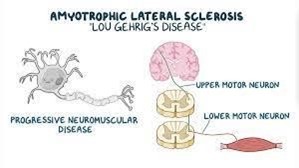A nurse is teaching a client who has amyotrophic lateral sclerosis (ALS) about the end stages of the disease process. Which of the following information should the nurse include in the teaching?
"You might wear splints over affected joints while you are sleeping."
"You will be given dexamethasone to treat muscle atrophy."
"You might require a machine to keep your airway open.
"You will receive nutrition through a central venous access device.
The Correct Answer is C
Choice A rationale:
Wearing splints over affected joints while sleeping is a strategy to prevent contractures, which are common in ALS.
Choice B rationale:
Dexamethasone is not used to treat muscle atrophy in ALS.
Choice C rationale:
As ALS progresses, clients may lose the ability to control their respiratory muscles, and a machine such as a ventilator may be required to assist with breathing.
Choice D rationale:
Nutrition through a central venous access device is not a standard intervention for ALS, as the focus is on preserving the client's ability to eat and swallow for as long as possible.

Nursing Test Bank
Naxlex Comprehensive Predictor Exams
Related Questions
Correct Answer is B
Explanation
Choice A rationale:
High-impact exercises might not be suitable for all clients and could potentially exacerbate symptoms such as joint pain or discomfort.
Choice B rationale:
Menopause is confirmed after 12 consecutive months without a menstrual period. Until this point, there is still a risk of pregnancy, and contraceptive measures should be used.
Choice C rationale:
Pelvic muscle exercises (Kegel exercises) are important for strengthening pelvic floor muscles but are not specifically related to menopause.
Choice D rationale:
Using a water-based lubricant for painful vaginal intercourse is a helpful suggestion, but it is not the primary focus of menopause education.
Correct Answer is D
Explanation
Choice A rationale:
Identifying whether incivility is present is important, but it's more proactive to initially focus on promoting a safe environment.
Choice B rationale:
Modeling professional behavior is essential, but addressing incivility requires a comprehensive approach that involves the entire team.
Choice C rationale:
Developing a zero-tolerance policy is important, but it should come after promoting a safe and respectful environment.
Choice D rationale:
Creating an emotionally safe environment fosters open communication and helps prevent incivility from occurring in the first place.
Whether you are a student looking to ace your exams or a practicing nurse seeking to enhance your expertise , our nursing education contents will empower you with the confidence and competence to make a difference in the lives of patients and become a respected leader in the healthcare field.
Visit Naxlex, invest in your future and unlock endless possibilities with our unparalleled nursing education contents today
Report Wrong Answer on the Current Question
Do you disagree with the answer? If yes, what is your expected answer? Explain.
Kindly be descriptive with the issue you are facing.
